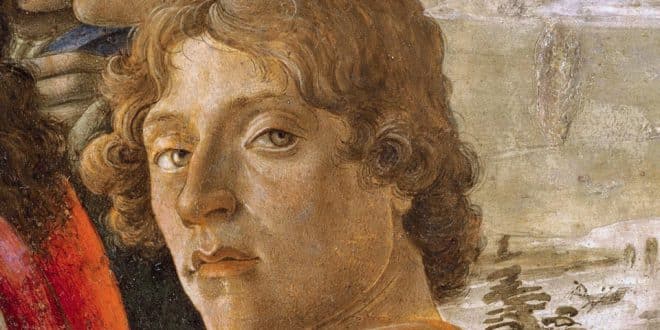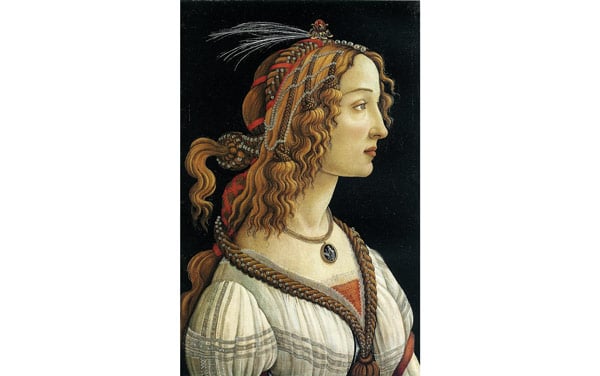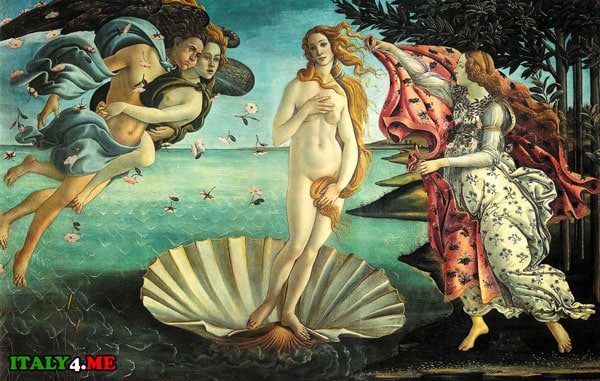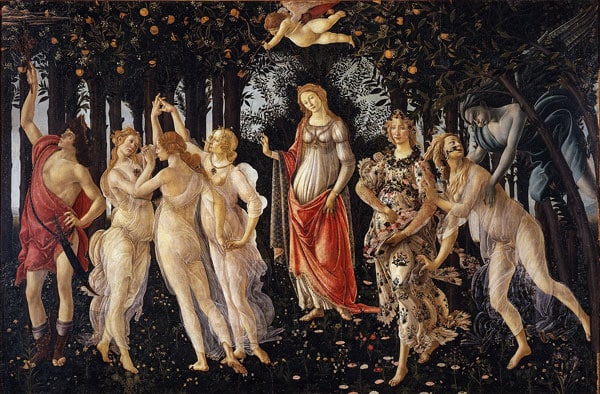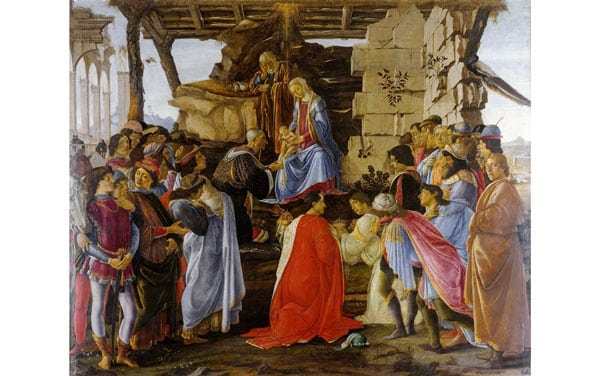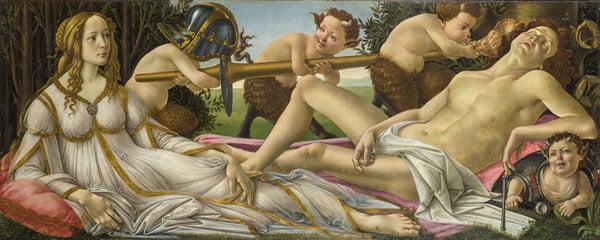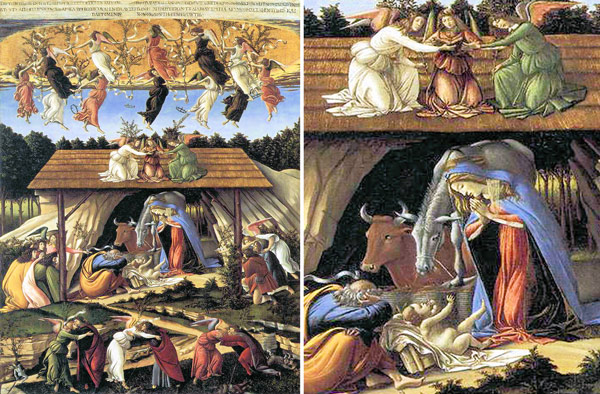The era of the Italian Renaissance is inextricably linked with the name of Sandro Botticelli (Sandro Botticelli). Even though the talented artist is recognized as one of the brightest representatives of the Florentine school of painting, his works were undeservedly forgotten for almost three centuries.
Interest in Botticelli’s work was revived in the mid-19th century. The master’s magnificent canvases are included in the collections of many world museums. They are rightfully considered true masterpieces of visual art.
Page Contents
Artist’s Biography
The real name of the painter is Alessandro di Mariano di Vanni Filipepi (Alessandro di Mariano di Vanni Filipepi). The primary source of information about the biography of the master and his creative path is the art history book by Giorgio Vasari, “The Lives of the Artists.”
Youth and Education
The future artist was born in 1445, in Florence (Firenze), in the family of a not wealthy craftsman. His father, Mariano di Giovanni Filipepi, was engaged in leather processing and had a small workshop, but the business did not bring significant income. Of the four children, Sandro (short for Alessandro) was the youngest child. One of his older brothers, Antonio, became a jeweler, and two others, Giovanni and Simone, dedicated themselves to commerce.
The initial education of Sandro was quite traditional for that time; like all children of the Filipepi family, he attended the parish school of the Dominican church of Santa Maria Novella (Basilica di Santa Maria Novella).
When the father died, the responsibility for supporting the family fell on the shoulders of the eldest son, Giovanni. Having become a wealthy merchant by that time, he was distinguished by a large physique, for which he received the nickname “Botticelli,” meaning “little barrel” in Russian, which subsequently passed to the other brothers.
From an early age, Sandro showed an inclination towards art. The talented 12-year-old teenager was first sent for training at the jewelry workshop of his older brother, Antonio. Later, in 1462-1464, on the recommendation of Giorgio Antonio Vespucci, a neighbor of the Filipepi family, the gifted young man went to learn the nuances of painting in the city of Prato, located 20 km from Florence.
There, he studied for 5 years in the workshop of the renowned artist Fra Filippo Lippi (Fra Filippo Lippi). Having returned to his hometown, Sandro continued his education. He became an apprentice of the Florentine sculptor and painter, Andrea del Verrocchio, one of whose students was the young Leonardo da Vinci (Leonardo da Vinci) at the time.
Creative Path
Sandro Botticelli’s success is inseparably linked with the name of the Medici, members of the influential clan who supported the artist’s talent and constantly provided him with work. He often attended meetings of the Platonic Academy in Careggi, which was under the patronage of Lorenzo the Magnificent (Lorenzo di Piero de Medici il Magnifico). The Neoplatonic ideas fervently discussed within the walls of the Medici villa defined the idealistic direction and humanistic motifs in the artist’s works. The fame of the outstanding painter quickly spread beyond Florence.
In 1481, he was invited to Rome (Roma), where, by order of Pope Sixtus IV, he painted the walls of the Sistine Chapel (Cappella Sistina).
Period of Crisis
The cultural, social, and political events in Florence left a profound mark on the artist’s work. In the 1490s, Botticelli, being by nature, as most geniuses are, a sensitive person with a delicate soul, came under the influence of the fanatical monk and reformer Girolamo Savonarola, who became the de facto unofficial ruler of the city. The advocate of morality fervently condemned in his sermons the tyranny of the Medici and the passionate life of those close to the influential clan.
Savonarola considered any expression of joie de vivre and beauty sinful, and together with his followers, he publicly burned artworks and secular books.
According to Giorgio Vasari, Botticelli personally threw his canvases into the bonfires lit in one of Florence’s squares. He virtually stopped painting, which led him to spend the rest of his life in great need. Works created by Botticelli in the late period of his career were characterized by asceticism and restraint in color palette. Savonarola himself was condemned and accused of heresy, which was a great shock to the artist. In 1498, the monk was executed by Pope Alexander VI Borgia.
Love and the Painter’s Muse
Little is known about the personal life of Sandro Botticelli. It is known that he never married and had no children. Some researchers believe that in his youth, the artist was secretly in love with Simonetta Vespucci, a Florentine beauty who captured the heart of Lorenzo the Magnificent, his younger brother Giuliano de’ Medici, and many other influential figures.
The beautiful maiden posed for many of Botticelli’s paintings. Simonetta died at 23, but even after her death, the artist continued to paint his muse from memory for many years, considering her captivating image the ideal of female beauty.
Old Age and Death
The last documentary mention of Botticelli’s life dates back to 1504. Surviving sources testify that the artist was a member of an extraordinary city commission, whose authoritative decision determined the location for the placement of the statue of “David” by Michelangelo (Michelangelo).
The later years of the master’s life were overshadowed by severe illness and poverty. Botticelli spent a long time in solitude, dying in 1510 at the age of 65. The artist’s body was buried in the cemetery of the Church of All Saints (Chiesa di Ognissanti) in Florence.
Paintings
A profound emotional crisis is felt in the paintings of his later period. The author’s changed worldview is reflected in many of his works, which are filled with drama and even some nervousness. The lyricism, linear rhythm, and rainbow palette gave way to artistic means characteristic of the Gothic period.
The Birth of Venus
“The Birth of Venus” is among the most recognizable of the artist’s works. It is believed to have been created between 1482-1486. According to one version, Botticelli painted the picture on the order of Lorenzo, the Magnificent’s cousin.
The basis of the plot is the story of the appearance of Venus, the beautiful goddess of carnal love and beauty (in Greek mythology, her name is Aphrodite), from the sea foam. The heroine is depicted nude, assuming a modest pose, standing in a shell floating on the waves. Zephyr and Aura create a gust of wind, helping her reach the shore, where the nymph of the seasons, Ora, awaits the goddess, prepared with a cloak decorated with flower patterns.
Botticelli’s work is permeated with spirituality. In Venus’s gentle face, the image of the Madonna is traced, and the outlines of her graceful body remind of ancient Greek statues. The compositional solution also conveys the emotional atmosphere: the figures are symmetrically positioned against a tranquil sky and sea, enhancing the sense of a harmonious union of spiritual and physical beauty. Botticelli’s timeless masterpiece is located in the Uffizi Gallery (Galleria degli Uffizi), in Florence.
I recommend visiting the individual tour of the Uffizi Gallery where you will see masterpieces by Italian masters and learn exciting facts.
Spring
The mysterious painting “Spring” was created in 1482 and commissioned by Lorenzo the Magnificent. The artist drew inspiration from the works of ancient Roman authors.
Botticelli depicted a scene from Lucretius’s philosophical poem “On the Nature of Things.” Some characters in the painting are prototypes from Ovid’s “Fasti,” which tells about ancient Rome’s festivals and holy days. The mythological characters gathered on a blooming meadow of an orange grove represent an allegory of the arrival of spring. The composition creates a sensation of a floating dance, with gestures and poses of the characters feeling incredibly light and rhythmic.
The debates among art historians about the artist’s true intent continued for many years. Researchers tend to see a deep philosophical, Christian, and even political subtext in the painting. Until 1743, the “Spring” belonged to the Medici family members.
After nearly 70 years, Botticelli’s work entered the Uffizi Gallery. However, it was only available to the general public for a short time as it was stored in the museum’s reserves. Fame and recognition came only in the early 20th century. Today, this painting is among the main exhibits of the gallery.
Read also about Caravaggio’s Paintings in Rome.
The Adoration of the Magi
The “Adoration of the Magi” is believed to have been created around 1475. Botticelli’s work, depicting the well-known biblical scene, so impressed his contemporaries that the master was commissioned to make about 7 author’s copies.
The artist’s work was intended to decorate the funerary chapel in the Basilica di Santa Maria Novella, the main Dominican church in Florence. The popular New Testament theme from the Renaissance era is filled with deep allegorical meaning.
The unique value of the painting lies in its characters, each persona linked to a real historical figure: members of the Medici dynasty, their close nobles, and honored citizens. In the right corner is Botticelli’s self-portrait, appearing as a fair-haired young man in a golden mantle. The bright color palette, the composition’s dynamism, the drawing’s precision, and the attention to the most minor details enhance the solemnity and festivity of the work. Botticelli’s magnificent painting is part of the artistic collection of the Uffizi Gallery.
Venus and Mars
The artist created the mythological work “Venus and Mars” around 1483.
The work was commissioned by a Florentine Vespucci (Vespucci) family member, , as evidenced by the depiction of a wasp swarm in the upper right corner of the painting – the heraldic symbol of the noble and wealthy family. Turning to the heritage of ancient culture was typical for the art of the Renaissance era.
In its allegorical figures, humanistic ideas are clearly read. Venus symbolizes love, beauty, and female power, capable of taming the ferocious energy of the god of war. In the semi-nude, sleeping figure of Mars, tranquility and absolute peace are felt. In the background, playful fauns jokingly play with weapons and armor, becoming unnecessary when harmony and love reign.
Botticelli’s work “Venus and Mars” is part of the art collection of the London National Gallery (The National Gallery) – official website www.nationalgallery.org.uk.
Mystical Nativity
The painting “Mystical Nativity” is dated 1501. The work belongs to the late period of the artist’s career when Botticelli was engrossed in religious ideas and tragically perceived the surrounding reality.
At this time, after the death of ruler Lorenzo the Magnificent, Florence was engulfed in political and military turmoil. The troubled situation in the artist’s hometown and sharp internal experiences, close to depressive disappointment, reflected the apocalyptic nature of the work.
People who came to worship the Christ child were dressed in contemporary clothes. The three principal angels at the top of the painting embody gratitude, justice, and truth – the highest values spoken of in one of Savonarola’s sermons. Notably, biblical shepherds and magi are absent from the work’s characters. Meanwhile, at the bottom of the painting, the artist depicted demons attempting to hide underground – images characteristic of the theme of the Last Judgment. Botticelli’s complex and largely enigmatic work has been in the London National Gallery since 1878.
 Italy for me From Italy with love
Italy for me From Italy with love

